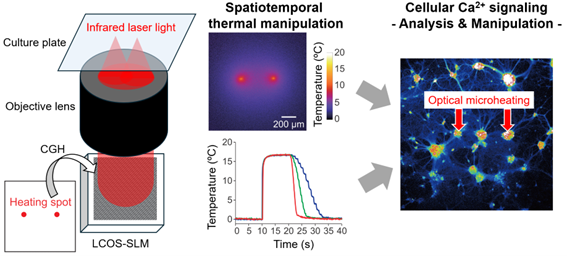![]()
NEWSIPR The University of Osaka
-

- NEWS
- 【Research Results Report】Illuminating cellular heat sensing with holographic heating microscopy -Holographic heating microscopy enables spatiotemporal temperature control, opening new ways to study how cells sense heat-
News
2025.10.10
【Research Results Report】Illuminating cellular heat sensing with holographic heating microscopy -Holographic heating microscopy enables spatiotemporal temperature control, opening new ways to study how cells sense heat-
Researchers at The University of Osaka, in collaboration with the National Institutes for Quantum Science and Technology (QST) and Waseda University, have developed a groundbreaking technique called holographic heating microscopy. This new approach allows scientists to manipulate temperature patterns in both space and time under the microscope, enabling real-time observation of how cells sense and respond to heat.
Temperature is one of the most essential cues for life, yet the cellular mechanisms of heat sensation remain poorly understood. Conventional heating systems can adjust overall culture conditions but cannot provide rapid, localized and patterned temperature changes during microscopic observation.
To overcome this challenge, the research team integrated a liquid crystal on silicon (LCOS) spatial light modulator (SLM) into an optothermal microscope. By projecting computer-generated holograms of near-infrared light, they achieved precise control over where and how quickly heat is applied. This innovation—termed holographic heating microscopy—makes it possible to deliver spatiotemporal temperature stimuli to targeted cells while monitoring their activity.
Using this system, the researchers observed thermosensitive calcium signaling in epithelial, neuronal, and cardiac cells. They also discovered that faster temperature changes evoke stronger cellular responses, highlighting the importance of thermal dynamics in biology.
The ability to finely tune temperature inside the microscope opens new possibilities for studying sensory mechanisms and regulating cell function. Beyond basic research, the technique could contribute to analyzing complex multicellular systems and developing precision thermal therapies.

Figure 1. Holographic heating microscopy for studying thermosensitive calcium signaling.
By displaying computer-generated holograms (CGH) on a spatial light modulator (LCOS-SLM), the distribution of near-infrared laser light at the focal plane can be precisely controlled (left). This enables spatiotemporal modulation of local temperature on the surface of a cell culture dish (center). Combined with fluorescence calcium imaging, the system allows selective optothermal stimulation and real-time observation of thermosensitive calcium signaling in targeted cells (right).
Publication
The results of this study were published in Lab on a Chip (Royal Society of Chemistry) in October 2025.
Title: Spatiotemporal temperature control by holographic heating microscopy unveils cellular thermosensitive calcium signalling
Authors: Kotaro Oyama*, Ayumi Ishii, Shuhei Matsumura, Tomoko G. Oyama, Mitsumasa Taguchi, Madoka Suzuki* (*Corresponding authors)
DOI: https://doi.org/10.1039/d5lc00675a
Funding: This work was supported by JSPS KAKENHI, JST PRESTO, the Takeda Science Foundation, the Tokuyama Science and Technology Foundation, and the Joint Research






